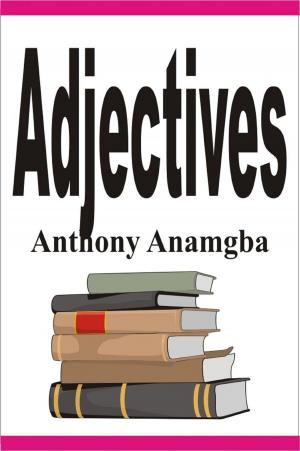| Author: | Anthony Anamgba | ISBN: | 9781370381555 |
| Publisher: | Anthony Anamgba | Publication: | March 15, 2017 |
| Imprint: | Smashwords Edition | Language: | English |
| Author: | Anthony Anamgba |
| ISBN: | 9781370381555 |
| Publisher: | Anthony Anamgba |
| Publication: | March 15, 2017 |
| Imprint: | Smashwords Edition |
| Language: | English |
Adverb modifies a verb, an adjective and sometimes, a fellow adverb. Adverb modifies and adds to the meaning of a verb, an adjective or another adverb. Adverb tells us more about a verb, an adjective or another adverb.
It is in this lucid manner that this book will teach you adverbs.
Adverb is of different types. They are the the adverbs of time, adverbs of place, adverbs of manner, adverbs of duration, adverbs of frequency, conjuncts and disjuncts.
It clearly explains the adverb of time. The adverb of time tells us when an action or event occurs. Adverb of time includes now, before, soon, presently, early, late, today, since, ago, ever and never.
It analyzes the adverb of place. The adverb of place tells us where an action or event occurs. The adverb of place includes near, far, above, under and everywhere
It appraises the adverb of manner. The adverb of manner tells us how an action or event occurs. The adverbs of manner comprise badly, courageously, well, wisely, bravely, beautifully, easily and steadily.
It evaluates the adverb of degree. The adverb of degree tells us the extent or degree an action or event occurs. The adverbs of degree include wholly, secondly, rather, quite, hardly, almost, half, about, twice, totally and completely.
It examines the adverb of duration. The adverb of duration shows how long an action or event lasts or takes. Adverbs of duration are long, always, forever and permanently.
It discusses the conjuncts and the disjuncts. Conjunct is an adverb that helps to introduce new sentences or link them to what has been said before. And disjunct is an adverb used to place a subsequent state of affairs in contrast with an already held belief or opinion.
It identifies how to position adverbs so that they can correctly qualify words. Adverbs are not positioned in a disorderly manner. Adverbs are positioned according to the functions they are expected to perform. It throws light on the guidelines on the correct order of adverbs.
It highlights the three degrees of comparison of adverbs. They are positive degree, comparative degree and superlative degree.
It points out the common mistakes in the use of adverbs. It throws light on the correct use of adverbs.
And it contains many crucial questions designed to enable you master how to use adverbs correctly.
Adverb modifies a verb, an adjective and sometimes, a fellow adverb. Adverb modifies and adds to the meaning of a verb, an adjective or another adverb. Adverb tells us more about a verb, an adjective or another adverb.
It is in this lucid manner that this book will teach you adverbs.
Adverb is of different types. They are the the adverbs of time, adverbs of place, adverbs of manner, adverbs of duration, adverbs of frequency, conjuncts and disjuncts.
It clearly explains the adverb of time. The adverb of time tells us when an action or event occurs. Adverb of time includes now, before, soon, presently, early, late, today, since, ago, ever and never.
It analyzes the adverb of place. The adverb of place tells us where an action or event occurs. The adverb of place includes near, far, above, under and everywhere
It appraises the adverb of manner. The adverb of manner tells us how an action or event occurs. The adverbs of manner comprise badly, courageously, well, wisely, bravely, beautifully, easily and steadily.
It evaluates the adverb of degree. The adverb of degree tells us the extent or degree an action or event occurs. The adverbs of degree include wholly, secondly, rather, quite, hardly, almost, half, about, twice, totally and completely.
It examines the adverb of duration. The adverb of duration shows how long an action or event lasts or takes. Adverbs of duration are long, always, forever and permanently.
It discusses the conjuncts and the disjuncts. Conjunct is an adverb that helps to introduce new sentences or link them to what has been said before. And disjunct is an adverb used to place a subsequent state of affairs in contrast with an already held belief or opinion.
It identifies how to position adverbs so that they can correctly qualify words. Adverbs are not positioned in a disorderly manner. Adverbs are positioned according to the functions they are expected to perform. It throws light on the guidelines on the correct order of adverbs.
It highlights the three degrees of comparison of adverbs. They are positive degree, comparative degree and superlative degree.
It points out the common mistakes in the use of adverbs. It throws light on the correct use of adverbs.
And it contains many crucial questions designed to enable you master how to use adverbs correctly.















